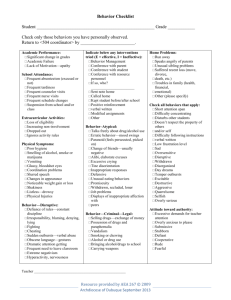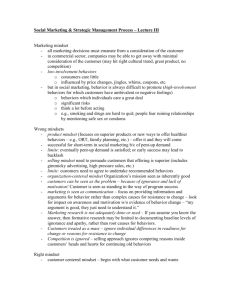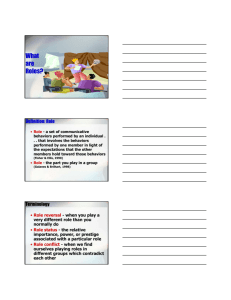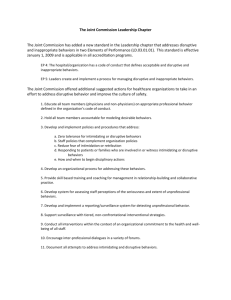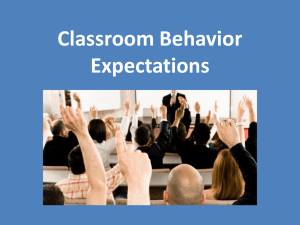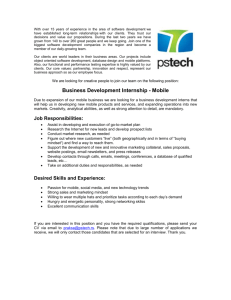Handling AnnOYING, Dangerous and disruptive
advertisement
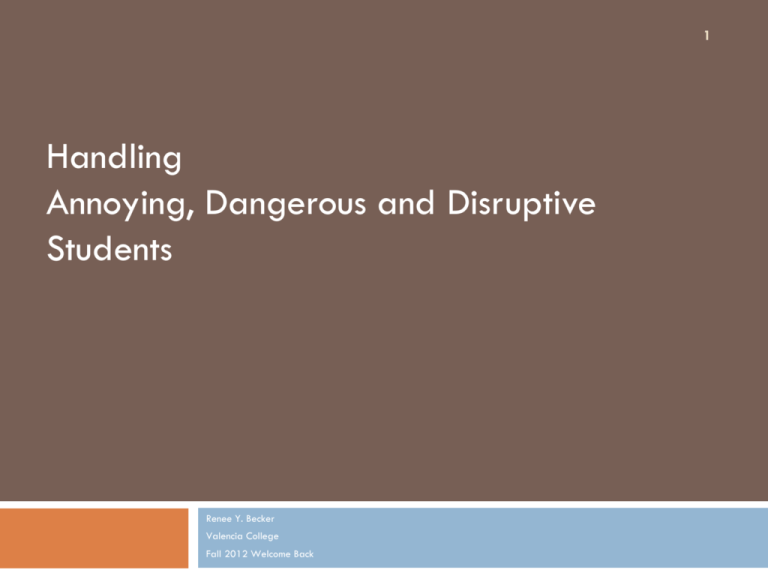
1 Handling Annoying, Dangerous and Disruptive Students Renee Y. Becker Valencia College Fall 2012 Welcome Back Core Concepts 2 Learn and use names Low-level intervention can prevent high-level issues Set expectations early and often Anticipate high-risk contexts Consider impact, not just intent Core Concepts 3 Intervene at lowest effective level Relationships are critical Students won’t change behavior if they don’t know what they’re doing wrong Overview 4 Annoying Dangerous Disruptive Dangerous 5 Acts of aggression Threats towards self or others Depression or hopelessness Endorsing violence or weapons Anger/Agitation/Inability to cope Seems out of touch with reality Disruptive 6 Yelling or being excessively loud Interrupting, not waiting for response Hygiene concerns Under the influence of substances Refusing to leave or cooperate Destruction of property Not responding to your instructions Annoying 7 Staring Not picking up on social cues Occupying personal space Wanting to speak to your Chair/Dean Disrespectful or rude behavior Threatening to sue you Monopolizing your time Poll #1 8 How do you feel when students exhibit these behaviors? 1. Frustrated 2. Scared 3. Annoyed 4. Uncomfortable 5. Not bothered at all Questions to Ask Yourself 9 Is there imminent danger? Is there a possible threat? Can I resolve this situation? If not, what can I do to help manage it until I can get support? What should I report and to whom? Strive to resolve the situation at the lowest level possible. Reporting/Referring 10 Recognize when to report: Document in your own notes Report to Dean Recognize when to refer: To campus police To campus resource Case #1 11 A student with Asperger’s disorder asks multiple, off-topic questions during class, engages in odd, repetitive behaviors and is teased by other students. The professor is concerned about the amount of time spent handling the student’s behavior as well as the impact of the teasing & bullying. Poll #2: What Bothers You Most? 12 1. Behavior gets in way of other students learning 2. Behavior interrupts your flow & teaching 3. Other students teasing the student 4. School admitting more students not ready for college 5. You handle more troubled students without training or pay Proper Mindset 13 Identify internal emotions Avoid generalizations Focus on problem at hand Stay calm, cool and collected Consider how you might be perceived Apply cycle breathing Cycle Breathing 14 Breathe in slowly to the count of 1…2…3…4… Hold your breath to the count of 1…2… Breathe out slowly to the count of 1…2…3…4… www.aggressionmanagement.com Setting the Stage 15 Talk to the student alone (if safe) Talk should be free of time pressure Seek to understand, not to judge Listen to his/her point of view Discuss with neutral tone; no sarcasm Build connection; working together Use Motivational Interviewing skills Setting the Stage 16 Motivational Interviewing involves: Expressing Empathy Developing Discrepancy Avoiding Argumentation Rolling with Resistance Supporting Self-Efficacy Case #2 17 A student behaves in an entitled manner. He texts in class, shows up late, gets up frequently to use the bathroom (or take a smoke break) & surfs the Internet during class. The student was asked to reduce these behaviors. He does not comply. The student smells of alcohol & talks about parties the night before. Poll #3: What Bothers You Most? 18 1. Frustrated with admissions standards 2. Angry/Anxious about lost lecture time 3. Not sure how to handle problems 4. Don’t like having to police students 5. Lack of compliance 6. Misuse of technology in class Poor 19 Don’t do this: Begin intervention annoyed & frustrated Make assumptions about their motivation Talk much; avoid listening Increase hierarchy between student/prof Good 20 Do this: Have a calm, cool & collected mindset Share concerns without judgment & assumptions; neutral, ‘just the facts’ Listen to student, show respect Align with the student toward success Avoid sarcasm Stay solution focused (what next?) Handling Difficult Conversations 21 Eight Step Outline for Difficult Conversations Describe the behavior & its impacts Listen to the their perspective & response Discuss appropriate behavior Discuss resources to promote success Reiterate or set parameters for future behaviors Handling Difficult Conversations 22 Eight Step Outline Share consequences for noncompliance Summarize Inform the conversation of any follow up: Document the conversation & plan Decide who you will inform Check in with the student, etc. Case #3 23 An older student emails her adjunct faculty member, challenging two exam questions & her grade. The faculty member responds via email. Then the student brings it up during class, becoming argumentative & enraged, resulting in her yelling & shoving a desk 6 feet across the room. Poll #4: What Bothers You Most? 24 1. Entitled attitude by student 2. Dangerous escalation in class 3. Student behavior stealing teaching time other students deserve 4. Student lacks responsibility for exam 5. Student’s lack of respect Aggression 25 Recognize both cognitive & physical Phases: Trigger, Escalation & Crisis Impact both professor & student “Am I making this worse or better?” Put aside attendance, grades Don’t be right & ‘punched in the head’ Meta Communication 26 Understand the content (what is being said) & process (how it is being said) Spoken: “This test question isn’t fair! It wasn’t on the study guide & the answers are vague.You need to change my grade!!” Unspoken: “I’m scared & lost in your class, I study hard but still fall behind” Meta Communication 27 How to help? Respond to the unspoken message to match the question being asked. Too often, we match defenses & anger. Focus on worry, concern & frustration underneath. As Covey says, “Seek first to understand and then be understood” Build a Connection 28 How to help? Calm mindset and develop rapport Build a bridge between you and them Realize the way you see things isn’t always the way they see things Crisis 29 See crisis response as a two-step model Address Calmly Discuss dangerous behavior first Redirect Behavior Separate Student Follow with proper backup/support You schedule the time and place Include Dean, police, counseling… Dismiss Class References 30 Magna Online Seminars, Dr. Brian Van Brunt Laura Bennett, M.Ed. www.aggressionmanagement.com
